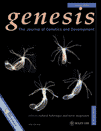The Drosophila RNA-binding protein Lark is required for the organization of the actin cytoskeleton and Hu-li tai shao localization during oogenesis
Abstract
Elimination of maternal expression of the Drosophila RNA-binding protein Lark results in female sterility. Here we show that this is due to a requirement during oogenesis. Developing oocytes from lark1 germline clones (GLCs) are often smaller than normal due to defects in nurse cell cytoplasmic “dumping.” Late-stage egg chambers from lark1 GLCs contain low levels of cortical and ring canal associated actin and completely lack nurse cell cytoplasmic F-actin bundles, suggesting the “dumping” phenotype is due to a defect in the actin cytoskeleton. Localization of Hu-li tai shao (Hts) protein, a component of ring canals, is also disrupted in these mutants. In addition to the dumpless phenotype, we observed a buildup of late-stage egg chambers, a phenotype that correlates with the decrease in egg-laying observed in the mutants. We postulate that this phenotype is due to defects in the cytoskeletal integrity of eggs since retained and oviposited eggs are fragile and often deflated. These mutant phenotypes are likely due to disruption of an RNA-binding function of Lark as similar phenotypes were observed in flies carrying specific RNA-binding domain mutations. We propose that Lark functions during oogenesis as an RNA-binding protein, regulating mRNAs required for nurse cell transport or apoptosis. genesis 40:90–100, 2004. © 2004 Wiley-Liss, Inc.




